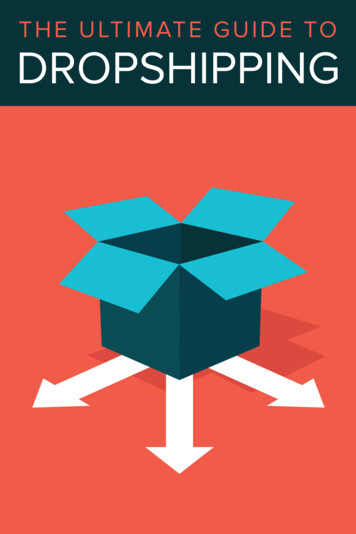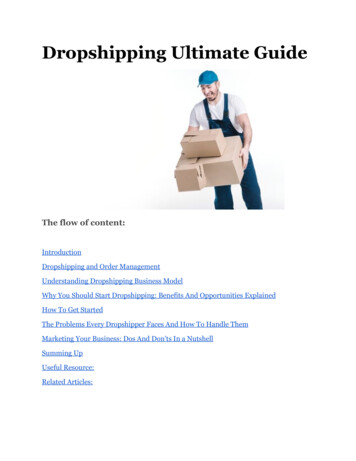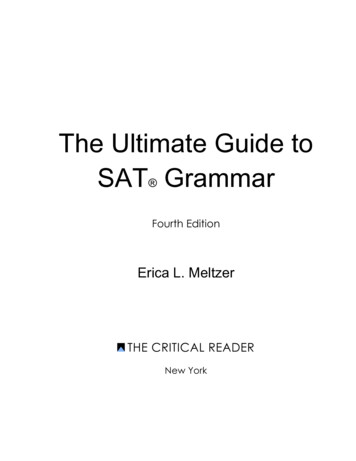
Transcription
The UltimateGuide to InsuranceAgent Training
CONTENTS1245910Nimble Is the New Normal for Insurance BusinessesAgent Training Is Critical to the Long-Term Profitabilityof Your Business“But We Already Provide Training!”: Why Your ExistingAgent Education Program Isn’t EnoughThree Elements to a Successful Agent Training ProgramGetting StartedAbout Cornerstone OnDemand
Nimble Is the New Normalfor Insurance BusinessesAccording to Deloitte’s Insurance Outlook 2017, the insurance industry isfacing new, dynamic challenges. Organic growth is slowing, while increasedcompetition and elevated customer expectations are making it even tougherto ensure steady sales. Changes in every industry, from self-driving carsto automation via robots, are disrupting business as usual, as is concernsaround shifting regulations.1But while the outlook is filled with challenges, there’s one type of insuranceorganization that will thrive amid uncertainty: the nimble, agile one.But while the outlook is filled with challenges, there’s one type of insuranceorganization that will thrive amid uncertainty: the nimble, agile one. Deloittestates that insurers must be “nimble to prosper in a rapidly changingbusiness environment,” and that includes upgrading from legacy systems,modernizing business models, and transforming products and services tobetter match customer demand.2But navigating changing regulations, increasing demand for 24/7 service,and evolving coverage and risk exposure models is going to requiremore than just an agile organization. While ensuring internal employeesare continually learning, insurance organizations must ensure externalemployees are learning just as fast—or faster.After all, agents are on the front line of the business, responsiblefor attracting and retaining customers. Agents are also ideal brandambassadors and revenue producers, as they’re highly invested not just intheir own success but that of the broader organization, as well. Yet whilethey may work independently, they don’t operate in a vacuum. While agentsbring motivation, work ethic, and drive, insurance companies can sustainand nurture that drive by providing continuous learning.1
Agent Training Is Critical to theLong-Term Profitability of Your BusinessWhy do new agents fail? While they often underestimate the work necessaryto be successful in the industry or go into the business for the wrongreasons (making money instead of also building relationships), new agentsaren’t successful when they aren’t given the skills and knowledge to be so.Yet both stumbling blocks can be addressed by one thing: great training.Training helps new agents gain technical skills, product and serviceknowledge, and legal and regulatory acumen. Yet the case for robust agenttraining doesn’t end there. In fact, how and when an organization developsits agents matters. After all, every insurance company provides sometraining, even if it’s simply the basics. But what separates the successful,long-term agent from the frustrated short-term one is training that goesbeyond initial operational and regulatory training.The financial rewards come, not immediately with a magical influx ofnew customers, but with consistent effort over long periods of time.Thus, training must also be treated as consistent effort that takes placeover time.To be successful, agents—and thereby insurance companies—must workhard for years, not just months. The financial rewards come, not immediatelywith a magical influx of new customers, but with consistent effort over longperiods of time. Thus, training must also be treated as consistent effort thattakes place over time.Training doesn’t just help create an engaged, profitable agent—and anequally profitable company. It also helps attract the right agents in the firstplace. Insurance agencies that provide robust, comprehensive, ongoingtraining are a beacon for committed, motivated candidates. The kind ofagent agencies want will expect to be have access to training designed tohelp them succeed.2
Research shows organizations also reap tangible improvements by providingongoing training, also referred to as extended enterprise learning. In a surveyconducted by Brandon Hall Group in 2017, organizations that facilitatedextended enterprise learning reported measurable business benefits:53 67 61%met or exceededcorporate objectives%%reduced training costincreased sales59 29%reduced trainingtravel time%reduced turnover3
“But We Already Provide Training!”:Why Your Existing Agent EducationProgram Isn’t EnoughContinuous employee training is crucial to creating the modern, agile,successful business. Organizations that implement comprehensive internalemployee training programs see reduced turnover, higher profits, and more.Yet it’s not just these internal employees who thrive on continuous training;external employees do, as well. Both internal and external stakeholders alsothrive on blended approaches, as well as development that enables learningon the job while also providing on-demand, bite-sized lessons.Yet as external employees, insurance agents have additional learning needs.An agent occupies a unique space within an organization: independent yetreliant, a solo operator who is also tangentially part of a tribe. Thus, trainingmust provide an agent with the opportunity to engage in structured learning,while simultaneously respecting the semi-independence and self-direction ofthe agent. Separated by psychical—and psychological—distance from peerswho often also play the role of competitor, agents still need opportunities forcollaborative learning and connection.Separated by psychical—and psychological—distance from peers whooften also play the role of competitor, agents still need opportunitiesfor collaborative learning and connection.It’s a tall order, further complicated by numerous other factors, e.g., agentexperience, career aspirations, legal and tax constraints on what canand cannot be provided to external employees. In fact, these factors giveinsurance agencies more in common with a technology company trainingits customers or a franchisee organization training its franchisees thanwith internal employee development. All three face the common challengeof needing to train a wide variety of external learners operating at differentlevels of independence.4
Three Elements to a SuccessfulAgent Training ProgramExtended, continuous training for agents is critical to ensuring consistencyand quality of services, reducing risk, and promoting the long-term financialsuccess of the organization. Yet the training needed is more complex thanan initial operations course or yearly conference. How then can companiescreate the right kind of training programs? By integrating the three keyelements that all successful agent training programs have in common: Learning that is continuous and structured to build skills and capacityover time. Learning that is just-in-time, asynchronous, and on-demand. Learning that is aligned with both agent and organization goals
1LEARNING IS CONTINUOUS AND STRUCTURED TO BUILD SKILLSAND CAPACITY OVER TIME.Successful agent training starts with basic operational skills and buildson those skills over time. In fact, in a profitable insurance organization,training is ongoing for both internal and external employees. As agentsgain experience and are ready for new knowledge, training responds inkind. Experts agree. According to Tom Minkler, insurance and risk analysisauthority at Clark-Mortenson Agency (as quoted in Agency Nation),“[Agencies need] to devote many hours over weeks, months, and years tohelp their staff develop the tools, confidence, and knowledge.”4For an insurance organization, this requires planning with the end in mind,namely how best to facilitate a logical skills progression. Because theinsurance industry is first a people business, new agents need to learncommunication and sales skills alongside basic operational ones. Ratherthan overwhelm agents with single week-long session, agencies cansupplement onsite development with a program that “drips” learning byproviding bite-sized, relevant lessons over time. Delivering training over timepromotes learning retention and enables new agents to start with basiccommunication and service skills—and then build logically upon those skills.Rather than overwhelm agents with single week-long session, agenciescan supplement onsite development with a program that “drips” learningby providing bite-sized, relevant lessons over time.Training can be viewed as an ongoing process, per Jeff Wodicka, chairmanand CEO Casswood Insurance, interviewed in IA Magazine. While thecompany used to begin training new agents with a two-week block oftechnical skills, Wodicka states it wasn’t effective. Instead, the agency nowuses a “circular” process, alternating between sales and relationship skillbuilding and technical and product development.5Experienced agents benefit from lifetime learning, beyond obtaining requiredcontinuous education credits. After both hard and soft skills are gained,agents can be offered opportunities tailored to their own goals and talents,such as business analysis, expanded sales and marketing techniques, andniche markets.6
2JUST-IN-TIME, ASYNCHRONOUS, AND ON-DEMAND.After initial training, franchisees will still need on-the-job instruction, asquestions and challenges will arise as a franchisee adjusts to the realitiesof a new business. Providing resources to answer these questions viatraining that is delivered at the right time is key to maintaining momentumduring the initial—and vulnerable—months of a new franchise. Deliveringknowledge as franchisees need it reduces frustration, sustains engagement,and improves retention.Providing resources to answer these questions via training that is deliveredat the right time is key to maintaining momentum during the initial—andvulnerable—months of a new franchise.Training also needs to be delivered with the right channel. Everyonelearns differently; offering franchisees a variety of learning opportunitiesaccommodates multiple learning needs. For example, training can beprovided within the context of a task to provide reinforcement for that taskor via gamification to stimulate interest and engagement.Training that is provided within the context of work is ideally supported withasynchronous learning. When training is available on a franchisee’s ownschedule, anytime and anywhere, franchisees are better able to find thatcrucial work-life balance and manage the stress of business ownership.When learning is bite-sized and on-demand, learning is also better retainedover time.3ALIGNED WITH BOTH AGENT AND COMPANY GOALS.An agent who has mastered relationship and sales skills, along with serviceand regulatory knowledge, is a powerful asset. Keeping that agent for lifecan yield tremendous financial and marketplace benefits. While robust andongoing training functions to support and engage agents, ensuring theagent’s goals align with the company’s nurtures loyalty and career longevity.Each agent has different talents and career aspirations. An insuranceorganization, while functioning as a generalized path for success, can alsoprovide tailored opportunities for the achievement of individual agent goals.7
An agent who has mastered relationship and sales skills, along with serviceand regulatory knowledge, is a powerful asset. Keeping that agent for lifecan yield tremendous financial and marketplace benefits.Thirty-percent of respondents in the 2017 Extended Enterprise Learningstudy stated they were able to cover more than 50% of their annual learningmanagement system (LMS) costs via extended learning revenues.6At this phase of training—that of offering agents customized learningaligned with aspirations—the organization may also realize a more monetaryROI. Motivated agents are often willing to pay for development that alignswith their goals. In fact, research by Brandon Hall Group showed thatorganizations recoup some costs of an extended enterprise technologyplatform by charging for certain content. Thirty-percent of respondentsin the 2017 Extended Enterprise Learning study stated they were able tocover more than 50% of their annual learning management system (LMS)costs via extended learning revenues.7
Getting StartedKnowing extended learning opportunities are beneficial to both agents and agencies is onething. Taking action to create a successful extended training program is another. The first step?Use this questionnaire to assess the effectiveness of your current program.L earning that is tailored to the lifecycle of the agent requires planning ahead. What short-term and long-term performance goals have been established for agents? Does current learning drive agents toward these goals in a logical, linear progression? What other opportunities do agents have in the organization, such as expanded ownershipor leadership, and does training support those paths? Has your organization matched ongoing training resources to one-, three-, and five-yearsales goals?D esigning, managing, and updating curriculum takes tremendous resources.Agents need a blend of soft and hard skills to be successful, including relationshipbuilding, legal acumen, technology skills, Has your organization considered using pre-packaged curriculum for soft skill development,and if not, what are the barriers to doing so, e.g., leadership resistance, budget, lack oftechnology that integrates ready training?C reating and managing a successful continuous learning program forextended employees requires not just planning but a platform. W hat technology are you using now to deliver on-demand, just-in-time, and collaborativelearning opportunities to agents? I s this technology seamless and integrated for delivery and reporting and analytics purposes? I s your existing learning management system capable of delivering bite-sized lessons in themoment of need? H ow could your organization benefit from a holistic system that integrates a variety of extendedlearning methods—including peer-to-peer communication and collaboration opportunities—aswell as real-time analytical capabilities?T raining offsite is expensive—airfare, meal, and hotel costs; material fees;instructors; etc. And the time agents spend away from the business to learn iseven costlier. B y reducing expensive, one-shot onsite training and delivering ongoing learning opportunitiesto agents offsite—via videos, forums, collaborative lessons, gamified lessons, and more—howmuch money could you save? C an you not only deliver engaging training but track and report on employee completion of thattraining? Knowing who engaged with what content and when (from taking a quiz to watchinga YouTube video) is crucial to managing development plans, performance improvement, andeven succession planning. I f learning were available as needed, i.e., just in time, how would that affect agent productivityand profit?9
About Cornerstone OnDemandCornerstone OnDemand (NASDAQ: CSOD) is pioneering solutions to helporganizations realize the potential of the modern workforce. As a globalleader in cloud-based learning and human capital management software,Cornerstone is designed to enable a lifetime of learning and developmentthat is fundamental to the growth of employees and organizations. Fromrecruitment, onboarding, training and collaboration, to performancemanagement, compensation, succession planning, people administrationand analytics, Cornerstone is there at every phase of the employeelifecycle. The company’s solutions are used by nearly 3,000 clientsworldwide, spanning more than 31 million users across 191 countriesand 43 languages.1. rvices/articles/insurance-industry-outlook.html2. rvices/articles/insurance-industry-outlook.html3. Brandon Hall Group/Cornerstone OnDemand. “Extended Enterprise Learning: A Profit Driver for Leading Organizations.”June 2017. Page 5.4. rance-agents/5. nt6. Brandon Hall Group/Cornerstone OnDemand. “Extended Enterprise Learning: A Profit Driver for Leading Organizations.”June 2017. Page 8.7. Brandon Hall Group/Cornerstone OnDemand. “Extended Enterprise Learning: A Profit Driver for Leading Organizations.”June 2017. Page 8Cornerstone OnDemand is the global talent management software provider that is pioneeringsolutions to help organizations realize the potential of a modern workforce. csod.com 2017 Cornerstone OnDemand moreinfo@csod.com 888-365-CSODStay connected:10
reduced training travel time 61% increased sales 29% reduced turnover3. 4 Continuous employee training is crucial to creating the modern, agile, successful business. Organizations that implement comprehensive internal employee training











